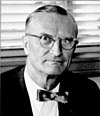Charles Dwight (Cap) Curtiss 1956

Charles Dwight (Cap) Curtiss grew up with the Bureau of Public Roads and the American highway system.
The name “Cap” came from Mr. Curtiss’ service as a captain with the U.S. Army Corps of Engineers during World War I in France.
Following the war, Cap Curtiss joined the Bureau of Public Roads and began a 38-year public service career.
Along with others in the Bureau who were destined to give this Nation a new concept in transportation at both the State and national levels, Cap Curtiss aided materially in the formulation of the policies and procedures of the amendments and expansions of the Federal-Aid Highway Act of 1916.
When he became Commissioner in 1956, plans for an enlarged and greatly expanded highway program reached out to every corner of the Nation.
With the signing of the Federal-Aid Highway Act of 1956 by President Eisenhower, it became Cap Curtiss’ responsibility to put into immediate operation the authorization of the largest public works program ever undertaken on a State-Federal cooperative basis.
John Anthony Volpe 1956–1957

John Anthony Volpe, who was to become the Nation’s second Secretary of Transportation, agreed to serve as interim Federal Highway Administrator from October 1956 to February 1957, pending confirmation by the U.S. Senate of Bertram D. Tallamy as Administrator.
Prior to his appointment as Administrator, Mr. Volpe had served nearly 4 years as the Massachusetts Commissioner of Public Works.
His personal history reflects the success story of the self-made man.
In 1933 he cashed a $300 insurance policy and borrowed $500 to begin a construction firm that was parlayed into a multimillion dollar organization.
The Volpe firm established a national reputation for construction excellence.
Mr. Volpe was elected Governor of Massachusetts in 1960, lost in 1962, and won a second term in 1964. He then was reelected in 1966 for the first 4-year term in the State’s history.
He was serving his third term when President Nixon swore him in on January 20, 1969, as the second Secretary of Transportation.
In 1973 John Volpe was appointed Ambassador to Italy, realizing his lifelong ambition.
Bertram D. Tallamy 1957–1961

Bertram D. Tallamy was an advocate of esthetic design in the Interstate System.
In administering the Interstate System, Mr. Tallamy wanted it fashioned after the New York Thruway, which in 1957 was generally regarded as one of the most magnificent highways ever constructed.
He wanted motorists to see the country, to enjoy the scenery, and above all to avoid monotony. All these things, he said, could be accomplished with an added safety factor without adding to the cost.
Mr. Tallamy also was in favor of regulated outdoor advertising along the Interstate System.
The first Senate-confirmed Federal Highway Administrator was born and bred to the engineering and construction fields. Both his father and grandfather were general contractors.
193
